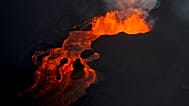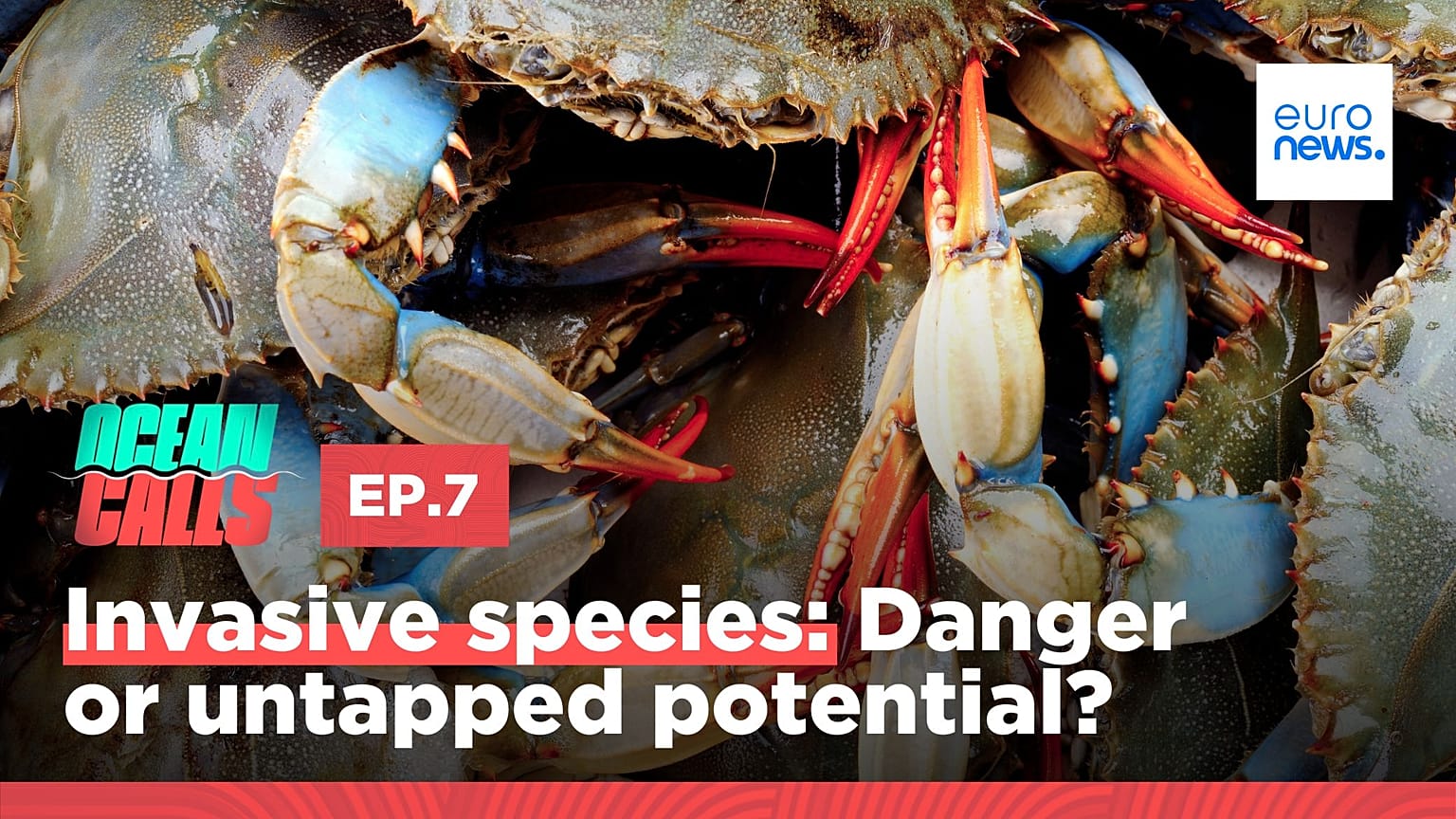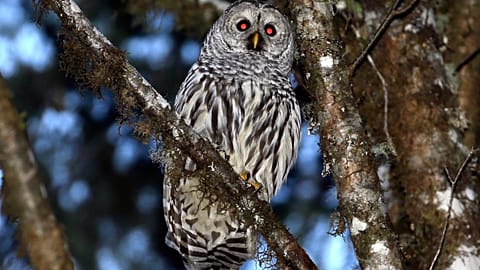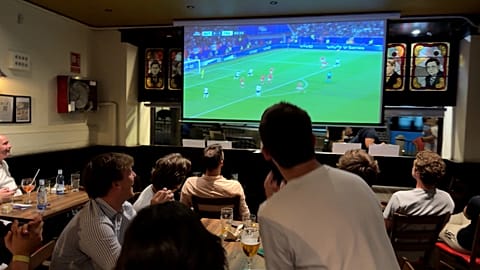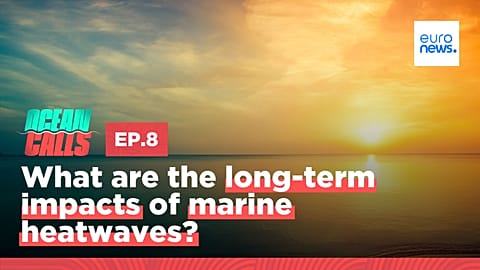Should we beat them, or eat them? In this episode of Ocean Calls, we’re embarking on a journey to unravel the mysteries of invasive species in EU waters. They unsettle the delicate balance of marine ecosystems, so what can we do about them?
With approximately 20 new non-native animals and plants discovered in European waters annually - and a staggering 70% of them found lurking in the Mediterranean - ocean experts are delving into the implications of these aquatic intruders.
In the idyllic waters of Madeira, which are home to 70 non-indigenous species, researchers stumbled upon a troubling find just two years ago: a brown algae with the name Rugulopteryx okamurae.
João Canning-Clode is the chairman of the Invasive Species Expert Group at ICES, the International Council for the Exploration of the Sea.
He describes this algae discovery as unprecedented, noting its rapid proliferation and “pest behaviour”. Not just blanketing beaches with its unsightly presence, this invasive algae has become a bane for tourists and a headache for local authorities, as well as those diving deeper into the ocean.
Despite attempts to repurpose it as fertiliser, its stubborn resilience underscores the challenges posed by non-native species.
It’s not just algae causing problems, there are also a number of invasive fish causing issues in the Mediterranean's troubled waters.
Voula Karachle, a research director at the Hellenic Center for Marine Research, lays bare a number of notorious invaders, including the poisonous silver-cheeked toadfish, Lagocephalus sceleratus.
Despite its innocuous appearance, it harbours a deadly secret: its flesh is laced with toxins, making it a potentially deadly choice for human consumers.
“We had some incidents, like in Greece and in Cyprus where… they didn't know what it was. They ate it. And then they were hospitalised for precautionary reasons,” Karachle says.
In the eastern Mediterranean region, she recalls that some 28 people have died after eating it.
What's the difference between non-native and invasive?
According to Canning-Clode, the key lies in their behaviour. While non-native species simply denote organisms found in new locations, invasive species are those that exhibit harmful ecological and economic impacts.
However, combating these invaders proves to be a near-Herculean task, and in some cases the fight is more reminiscent of Sisyphus and his rock. Unlike terrestrial ecosystems, where containment is feasible, the vast expanses of marine environments present formidable challenges.
“When we talk about the aquatic environment and especially the seas, there are no borders,” Canning-Clode says, “There's always a lag… of us spotting it and in cases we spotted it, it’s perhaps already gone away out of our possibilities [of solving the issue].”
If possible, prevention is far better than cure, and prevention only happens through early detection and intervention. Eradication efforts often prove futile, as evidenced by failed attempts in the Azores.
“Our colleagues in the Azores, they found green algae in the harbour of one of the islands, and they spent more than €1 million trying to eradicate it, with a lot of divers with copper blankets and other methods,” Canning-Clode explains.
“They were not successful and they quit. It's really, really difficult,” he laments. “Our prime goal should be prevention.”
So, where do we go from here? In the battle against invasive species, collaboration emerges as our most crucial weapon. By fostering synergies between scientists, policymakers and laypeople, it’s easier to bolster prevention efforts and develop robust mitigation strategies. Early detection, coupled with swift action, could well hold the key to stemming the tide of invasive species and preserving the rich biodiversity of the Mediterranean.
Plus, there’s also another solution you might not have considered.
Beat them or eat them: A more unusual solution to the issue
“If we cannot beat them, we should eat them,” Karachle explains, “they are edible. They are tasty.”
That’s if you exclude the pufferfish, of course.
She and her team examined four invasive species in the Mediterranean and discovered that they are extremely rich in essential, fats. Her aim now is to get fishers to choose to catch them and to see these creatures scaled up in the industry, turning them into “smoked, salted, canned, jerky” products.
While many fishers and industry experts are already on board with these species, “the consumers are another issue” she says.
The solution? “We've been launching campaigns like, having well known chefs, cooking them, providing people with recipes online, having events in restaurants," Karachle enthuses.
If the thought of eating these fish isn’t appealing to you, there are other options - wearing invasive species as handbags.
“My friend Aylin Ulman in Turkey, she has developed a small company and she's taking the leather. And they are producing extremely, very beautiful clutches and purses, Karachle says. Ulman is the brains behind Pufferfish Leather, which uses invasive but not endangered species to make these unusual creations. As well as using these fish, they put a focus on improving their environmental footprint, as well as practicing sustainable fishing practices and eco-friendly tanning processes.
Canning-Clode is slightly less enthusiastic at that prospect, though.
“I think I have a more conservative view,” he says, “There are positive uses of non-indigenous species - but I think that the positive benefits of invasions do not outweigh the negative impacts.”
If you want to learn more about the myriad invasive creatures in the Mediterranean sea, listen to the full episode of Ocean Calls in the player above.
In this episode of Ocean Calls, we're investigating the truth behind these alien species - and how best to deal with them.
We’ll be calling on the expertise of João Canning Clode, Chairman of the Invasive Species Expert Group at ICES, the International Council for the Exploration of the Sea and Voula Karachle, an expert on invasive species from the Hellenic Centre for Marine Research.
At the end of the episode, you'll hear the story of Amjad Almatni, a young Syrian activist from the drought-affected region in Syria, about the magical moment when he saw the ocean for the first time in his life.
Ocean Calls is produced in partnership with the European Commission’s Directorate-General for Maritime Affairs and Fisheries.


